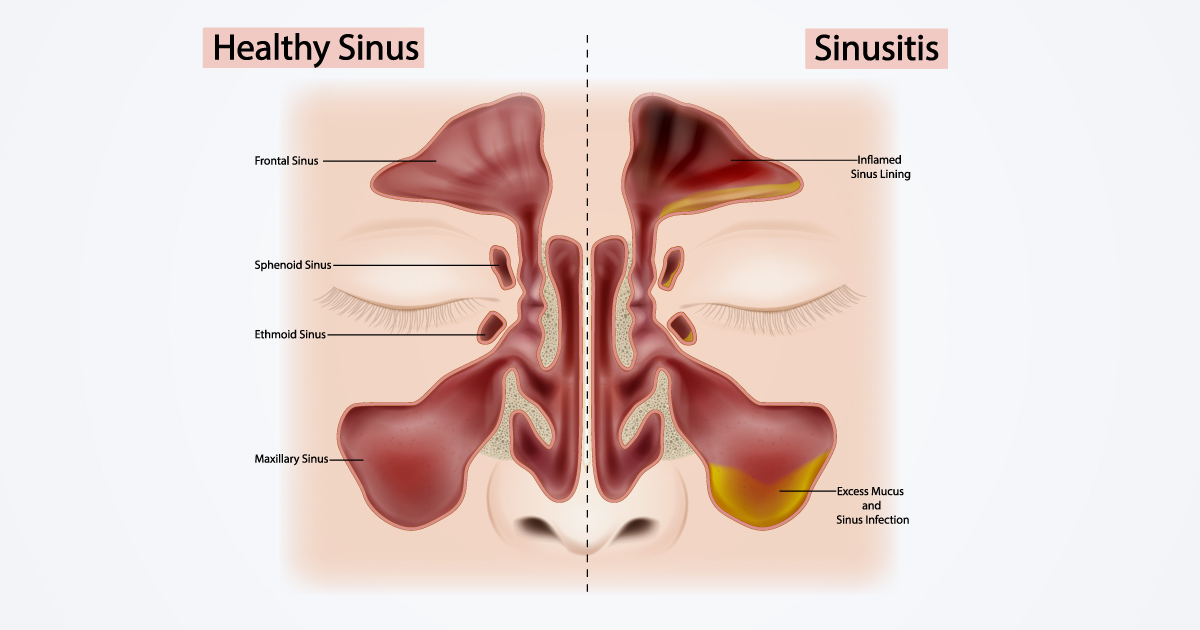Sinusitis symptoms may resemble a cold or allergic rhinitis. In addition to nasal congestion, runny nose or mucus, there may also be headaches, facial pain, and decreased sense of smell. If left untreated for a long time, it may become severe, affecting daily life.
What is Sinusitis?
Sinusitis occurs from inflammation of the sinuses, which are air-filled cavities around the nose. It can be an infectious or non-infectious inflammation. Infections may be bacterial, viral, or fungal. However, commonly when referring to sinusitis without specifying a different cause, it usually means a bacterial infection.
Why is Sinusitis important?
- It is a common disease causing undesirable symptoms such as nasal congestion, mucus, post-nasal drip, cough, facial pain, toothache, headache, decreased sense of smell, nasal sound, foul odor in the nose, fever, fatigue, and ear fullness.
- It may lead to dangerous complications such as infections spreading to the eyes and brain.
- There may be serious underlying causes such as hidden tumors or fungal masses in some cases.
- Proper and appropriate care, including identifying and treating any underlying causes, yields good results with fewer complications.

How many types of Sinusitis are there?
There are several types of sinusitis, including:
- Acute Inflammation with symptoms lasting less than 3 months
- Chronic Inflammation with symptoms lasting 3 months or more
- Acute on Chronic Inflammation in cases with existing chronic inflammation
- Recurrent Acute Inflammation occurring acutely 4 times a year or more
Why does Sinusitis develop?
Sinusitis is a disease that arises from multiple factors, not just a single cause. Acute sinusitis often begins with a cold, with a minority caused by other factors such as dental issues or diving. In chronic or recurrent sinusitis, there may be underlying factors promoting the condition, preventing resolution or causing frequent recurrence. Identifying and treating these underlying causes alongside may enhance therapeutic outcomes.
Common underlying causes of chronic or recurrent sinusitis include:
- Obstruction of sinus openings or mucus pathways due to abnormal physical structures or swelling from allergies or air pollution around these areas.
- Abnormal mucus clearance from sinuses into the nasal cavity due to excessively thick mucus or malfunctioning microscopic hair (cilia) on sinus epithelial cells.
- Infection from other organs such as inflamed dental roots.
- General immunological abnormalities like excessive inflammatory cells in sinus mucosa or weakened immunity.
- Other diseases including recurrent respiratory disease due to non-steroidal anti-inflammatory drugs, enlarged adenoids obstructing nasal passages, acid reflux from the esophagus, or fungal masses in sinuses.

What are the symptoms of Sinusitis?
Sinusitis can present various symptoms. Main symptoms include nasal congestion and cloudy mucus or post-nasal drip. Secondary symptoms include facial pain or tension, decreased or lost sense of smell. If at least 2 symptoms, including at least 1 main symptom and some secondary symptoms, persist beyond 10 days or worsen after 5 days, the likelihood of sinusitis is high. The chances increase if the mucus has a pus-like appearance, resembles an upper toothache or unilateral cheek pain, or is accompanied by fever.
How is Sinusitis diagnosed?
Diagnosis to confirm sinusitis may include using a nasal speculum to examine the front nasal cavity, a mirror to inspect the back nasal passage, and an endoscope for nasal cavity examination. Endoscopic examination is preferred due to the use of local anesthetic, minimal discomfort, and brief procedure time. X-rays may supplement diagnosis; however, interpretation requires caution. Standard X-rays can yield false positives and negatives, while CT scans give a high rate of false positives, as nearly 90% of ordinary cold patients showing sinus abnormalities on CT are not actual cases of sinusitis.
How is Sinusitis treated?
Treatment of sinusitis focuses on reducing mucosal inflammation, eradicating causative pathogens, and improving sinus drainage of mucus and air. Addressing underlying factors contributing to sinusitis and alleviating patient symptoms can involve medication and surgical options.

How is Sinusitis treated with medication?
Medication for sinusitis primarily includes antimicrobial agents, nasal steroid sprays, saline nasal rinses, and non-drowsy antihistamines (for allergic rhinitis cases).
- Acute sinusitis: Doctors often recommend saline nasal rinses, nasal steroid sprays, and antimicrobials in cases of confirmed bacterial infections. Nasal steroid sprays help reduce inflammation in both infectious and non-infectious inflammation, while saline rinses benefit cases with thick, sticky mucus.
- Chronic sinusitis: Doctors frequently suggest saline nasal rinses with nasal steroid sprays. Antimicrobials are less commonly used than in acute inflammation, but some cases might require prolonged courses to reduce inflammatory cells rather than targeting microbes.
Besides medication, it is important to rest adequately and avoid factors causing nasal mucosal swelling, such as irritants and alcohol. Those who experience nasal congestion frequently after swimming should refrain from swimming.
When is Sinusitis surgery necessary?
For acute sinusitis, it is generally resolved within 1-2 weeks after treatment. However, chronic or recurrent sinusitis cases require identifying and managing underlying causes beyond medication, as mentioned earlier.
- Some causes are manageable with medication and avoidance, such as chronic nasal inflammation from allergies or non-allergic causes, cold, cigarette smoke, air pollution, etc.
- Some causes require surgery, such as structural abnormalities, growths, enlarged adenoids causing obstruction, and fungal masses in the sinuses.
- Some causes are either unmanageable or less effectively treatable, such as thick mucus or abnormal cilia hindering mucus clearance or generalized immune dysfunction.
Surgery is often necessary to improve conditions for some patients alongside underlying causes requiring surgical intervention. Other surgical indications include:
- Complications from sinus inflammation, such as ocular inflammatory conditions or abscesses and cerebral complications, require urgent surgery.
- Underlying causes necessitating surgery as discussed earlier.
- Protracted sinus opening obstruction leads to excessive mucus accumulation causing sinus wall bulging.
- Patients who have not responded to maximal medication or non-surgical approaches within 6-12 weeks.
What are the steps in Sinusitis surgery?
Typically, surgery involves general anesthesia, using an endoscope inserted through the nasal passage to the targeted area for surgery. Modern tools, particularly the Microdebrider (Powered Instrumentation), provide convenience, precise tissue removal with minimal impact on healthy tissue, less bleeding during surgery, and minimal need for nasal packing afterward. It ensures minimal postoperative discomfort, restored nasal breathing, and overall better surgical outcomes.
The Microdebrider was first used worldwide around 1996, introduced for sinus surgery in Thailand in 1998, and is now considered a standard tool for sinus surgeries.
The Navigator system, another tool, enhances surgical efficiency in certain areas for specific patients. Nevertheless, it requires a surgeon proficient in sinus anatomy and structure. The extent of surgery depends on individual patient needs, determining which sinuses require intervention and the amount of sinus wall removal necessary.
Benefits of Sinusitis Surgery
Sinuses are beneficial anatomical structures designed by nature to prevent direct exposure to nasal cavities. Sinus surgery involves expanding sinus openings and creating direct passageways for sinus mucus into the nasal cavity, facilitating easier mucus clearance. Saline rinses can enter sinuses during nasal irrigation, and medications mixed in saline reach sinus linings effectively.
Conversely, nasal contents can also access sinuses easily, potentially aggravating viral sinusitis during colds. Extensive surgeries, like Full-House FESS, integrate all 5 sinuses with the nasal cavity, and extended endoscopic surgeries may involve partial removal of inner nasal cavity tissue. Therefore, surgery must be well-indicated, meaning broadly validated as necessary or beneficial more than non-surgical means, targeting only essential sinus areas without unnecessary disruption.
Surgery techniques range from Limited Endoscopic Sinus Surgery, Functional Endoscopic Sinus Surgery (FESS), Full-House FESS, Reboot Endoscopic Sinus Surgery, to Extended Endoscopic Sinus Surgery. Each patient presents unique conditions and surgical objectives, dictating appropriate surgical choices. Suitable techniques depend on sinusitis type, balancing effective results with minimal impact on remaining healthy sinus parts. Inadequate surgery may result in unresolved disease, while excessive surgery increases unwarranted risks and potential adverse effects on natural sinus and nasal functions.
Side Effects of Sinusitis Surgery
Sinuses are anatomical structures adjacent to crucial organs like the side-located eyes and brain above; thus, sinus surgery entails potential risks of breaching into these areas.
Possible side effects vary from self-resolving periocular bleeding to blindness if ocular breaches occur, and cerebrospinal fluid leaks if brain breaches occur, necessitating surgical repair. However, these effects are rare, and surgeons are well-versed in sinus anatomy and structure, minimizing risks. Other manageable complications include postoperative bleeding, addressed with hemostatic materials or cauterization at bleeding sites.
Recommended Sinusitis Treatment Centers
The Ear, Nose, and Throat Center at Bangkok Hospital offers comprehensive sinusitis care. With experienced specialists and multidisciplinary teams, patients receive close consultation and support, enabling the restoration of confident, happy lives.
Specialist in Sinusitis Treatment
Dr. Songklot Aeumjaturapat, a specialist in Ear, Nose, and Throat from the ENT Center at Bangkok Hospital.
Sinusitis Surgery Package
Sinusitis treatment surgery package starting at 157,000 Baht









